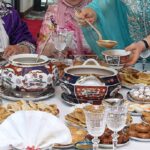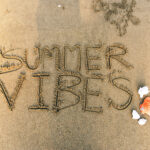Eid al-Fitr is a joyful Islamic holiday in Morocco. It ends Ramadan fasting. Families and communities come together, showing faith and tradition.
They share meals and make memories. This celebration is special.
In Morocco, Eid al-Fitr mixes religious customs with local traditions. It’s celebrated everywhere, from cities to villages. Moroccans honor their Islamic heritage and national identity.
On Eid morning, Moroccans wear their best clothes and pray together. The smell of sweets and happy greetings fill the air. Kids look forward to gifts, and adults share warm wishes.
This shows the faith and family bonds in Morocco.
Key Takeaways
- Eid al-Fitr marks the end of Ramadan in Morocco
- Families gather for prayers and festive meals
- Traditional sweets play a central role in celebrations
- New clothes are worn to honor the occasion
- Gift-giving is a cherished custom, especially for children
- The holiday blends Islamic traditions with Moroccan culture
The Historical Significance of Eid al-Fitr in Morocco
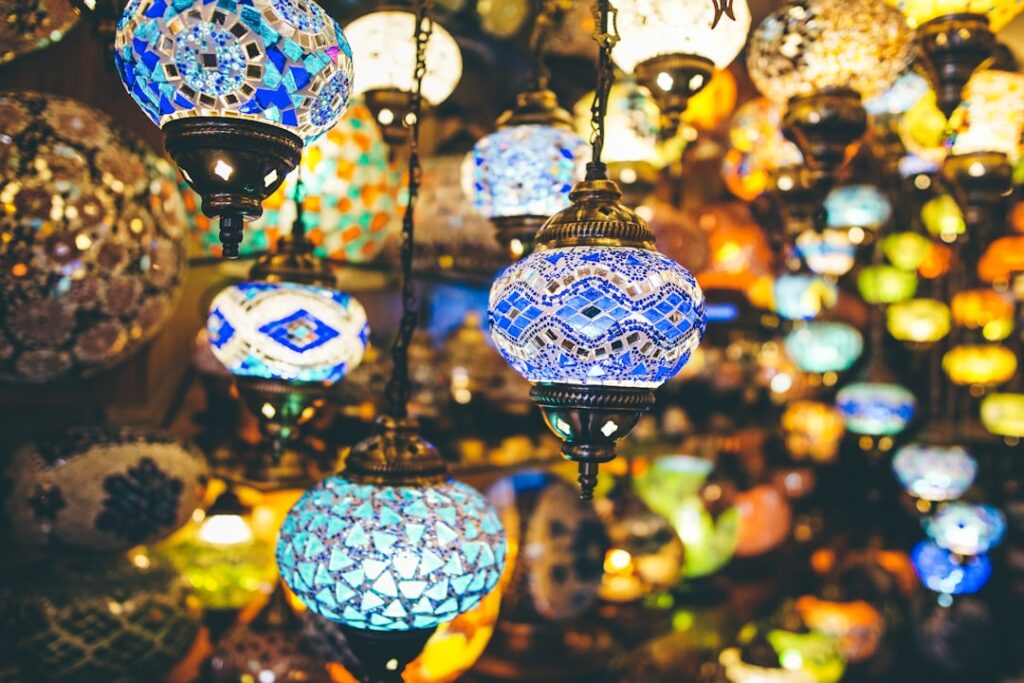
Eid al-Fitr is deeply rooted in Morocco’s Islamic heritage. It celebrates the end of Ramadan with joy. This festival blends religious devotion with Moroccan traditions.
The history of Eid al-Fitr in Morocco goes back to the early Islamic period. It has shaped the country’s culture for centuries.
Origins and Islamic Heritage
Moroccan traditions during Eid al-Fitr come from Islamic practices. Families come together for prayers and meals. They also exchange gifts.
These customs show the values of Islam. They highlight community, charity, and gratitude.
Evolution of Moroccan Eid Traditions
Over time, Moroccan Eid celebrations have changed. They now include local cultural practices. Traditional clothes like colorful jellabas and babouche slippers are worn.
Moroccan food also plays a big role. Special dishes are made only for Eid.
Cultural Fusion in Modern Celebrations
Today’s Eid al-Fitr in Morocco is a mix of old and new. It keeps its religious importance but also adds modern touches. Families might go to parks or beaches.
This mix shows Morocco’s ability to keep its heritage alive. It also shows its openness to change.
How Moroccans Celebrate Eid al-Fitr

Eid al-Fitr in Morocco is a time of joy and celebration. Families wear new clothes and go to mosques for special prayers. Everyone greets each other warmly, filled with happiness.
After prayers, families enjoy a big breakfast together. They eat msemen and baghrir, and sweet treats like chebakia and dates. It’s a feast to start the day.
People then visit their loved ones, sharing meals and gifts. Kids get money or small presents, making it even more fun. Parks and public spaces are filled with laughter and picnics.
The celebrations end with community gatherings. Neighbors share food and stories, filling the streets with laughter and music. This festival strengthens family bonds and celebrates their culture.
Preparing for Eid: Pre-celebration Customs
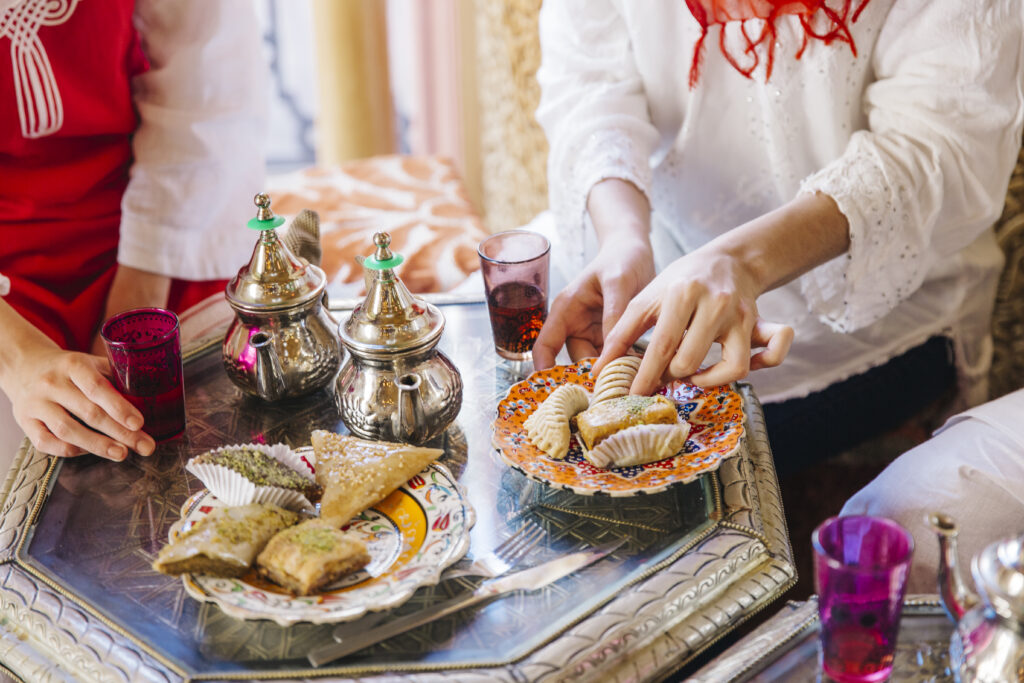
Moroccan traditions shine brightly during Eid al-Fitr preparations. Families do lots of activities to welcome this joyous occasion. These customs show the deep cultural practices that make Moroccan Eid special.
Home Cleaning and Decoration
Moroccan homes change in the days before Eid. Families clean every corner, starting fresh. They decorate with colorful textiles and lanterns, showing Moroccan hospitality.
Shopping for New Clothes
Buying new clothes is a cherished Eid tradition. Moroccan markets are busy with people picking out their best outfits. Kids especially love this, choosing colorful djellabas or modern clothes for the celebrations.
Preparing Traditional Sweets
The smell of sweet treats fills Moroccan kitchens before Eid. Families make beloved pastries like chebakia and sellou. These recipes have been passed down, keeping Moroccan culinary traditions alive.
Morning Rituals and Prayer Ceremonies
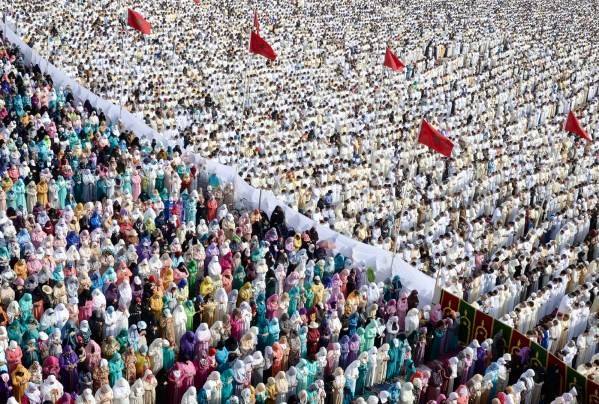
Eid al-Fitr is a big Islamic holiday in Morocco. It starts with morning religious rituals. Families get ready as the sun rises.
Everyone wears their best clothes. They go to mosques or open spaces. The excitement is in the air.
The Eid prayer is the first step of the celebration. Thousands of people come together. It’s a beautiful sight of devotion and unity.
The imam leads the prayers. His voice is filled with thanks for Ramadan’s blessings. This moment brings Moroccans together.
Before the prayer, people give zakat al-fitr. It’s a charity to help everyone celebrate. Giving alms shows the holiday’s spirit of kindness.
After the prayer, people say “Eid Mubarak!” to each other. It’s a time to connect with friends and strangers. The day’s celebrations start after the rituals.
These rituals remind Moroccans of their faith and values. They strengthen family and community bonds. As people leave the prayer grounds, Eid festivities fill the streets and homes.
Traditional Moroccan Eid Breakfast
The Eid breakfast in Morocco is a feast for the senses. Families gather to share a meal that showcases the best of Moroccan cuisine. This special morning meal brings loved ones together to celebrate the end of Ramadan with joy and gratitude.
Essential Breakfast Components
A typical Eid breakfast table is laden with diverse dishes. Msemen, flaky Moroccan pancakes, and baghrir, spongy thousand-hole crepes, are staples. These are often served with honey or jam. Savory options include eggs, cheese, and olives. The aroma of mint tea fills the air, completing the sensory experience.
Special Eid Morning Treats
Eid morning brings unique delicacies to the table. Families prepare chebakia, a honey-coated sesame cookie, and sellou, a sweet nutty flour blend. These treats, made only for special occasions, add to the festive atmosphere and delight both young and old.
Family Gathering Customs
The Eid breakfast is more than just a meal; it’s a cherished family tradition. Extended family members come together, often dressed in new clothes. They exchange warm greetings and share stories. This gathering sets the tone for a day filled with love, laughter, and continued celebrations of Moroccan culture and traditions.
Visiting Customs and Family Traditions
Family gatherings are key in Eid al-Fitr celebrations in Morocco. Families start early to visit relatives and friends. This is called ziyarat and follows a set order, starting with the eldest.
Visits are short but full of meaning. Guests get warm welcomes, sweets, and mint tea. Kids get small gifts or money, known as Eidiya. These visits help families and communities feel closer, showing Eid’s spirit.
Eid al-Fitr in Morocco is also about making amends. People use this time to fix broken relationships and solve conflicts. You might hear “May God forgive us” a lot, showing forgiveness and new starts.
The day ends with big family meals. Many generations gather to share food and joy. This tradition shows the true spirit of Eid al-Fitr in Morocco, focusing on unity, forgiveness, and happiness.
Special Moroccan Dishes Served During Eid
Eid al-Fitr in Morocco is a feast for the senses. Food plays a big role in the celebration. Families gather to enjoy traditional dishes together.
Main Course Specialties
Lamb tagine is a highlight of Eid. It cooks for hours, filling homes with amazing smells. Couscous, a Moroccan favorite, is often served with the tagine. It’s topped with tender veggies and savory broth.
Traditional Desserts and Sweets
Sweets are a must at Eid. Sellou, a nutty treat, is a favorite. Chebakia, honey-soaked pastries, offer a sweet and crunchy delight. Kaab el ghazal, almond paste-filled crescent cookies, are loved by all.
Beverage Traditions
Moroccan mint tea is everywhere during Eid. It’s a sign of welcome. Some families also make special fruit juices or almond milk to go with meals.
These food traditions do more than fill bellies. They bring families and communities closer. Enjoying these dishes together creates memories and celebrates Moroccan culture.
Gift-Giving Practices and Celebrations
Gift-giving is a big part of Eid al-Fitr in Morocco. It makes families closer and brings happiness to communities. Kids look forward to getting money gifts, called Eidi, from their elders.
Adults also give presents to show love and thanks. This makes everyone feel special.
Moroccan families love to go on special outings during Eid. They might have picnics, visit amusement parks, or go to the beach. These activities make memories and keep traditions alive.
But giving isn’t just about presents. Many Moroccans also help their communities during Eid. They give to charities or volunteer, showing the true spirit of Eid. This brings people together and shows the importance of helping others.
Family gatherings are key to Eid celebrations in Morocco. Families come together to eat, exchange gifts, and have fun. These times help pass down traditions to the next generation.
Community Festivities and Social Gatherings
Eid al-Fitr in Morocco is filled with joy. People come together to celebrate. They show their cultural pride and share in the holiday spirit.
Neighborhood Celebrations
Children laugh as they play traditional games in the streets. Families give warm hugs and sweets to their neighbors. They also have potluck dinners to share local foods.
Public Events and Activities
Cities in Morocco have big celebrations for Eid al-Fitr. There are colorful parades and music. Parks become fairgrounds with rides and games for everyone.
These events help people feel connected. They share in the joy of Eid and celebrate together. For Moroccans, these gatherings are key to the holiday, building unity and pride.
Regional Variations in Moroccan Eid Celebrations
Morocco’s diverse landscape shapes unique Eid al-Fitr celebrations across the country. From bustling cities to remote villages, each region adds its own flavor to this joyous occasion. The blend of moroccan traditions and cultural practices creates a rich tapestry of festivities.
In coastal cities like Casablanca and Tangier, families often gather for beachside picnics after morning prayers. They savor seafood dishes and enjoy the cool ocean breeze. Mountain communities in the Atlas region celebrate with traditional Berber dances and music, showcasing their distinct cultural heritage.
Desert dwellers in the Sahara mark Eid with camel races and elaborate feasts under starry skies. The oasis town of Merzouga is known for its sand baths, believed to bring good fortune for the coming year. Rural areas focus on agricultural bounty, incorporating freshly harvested produce into their Eid meals.
Urban centers like Marrakech and Fez blend modern and traditional practices. Here, you’ll find grand mosque gatherings alongside trendy cafes serving Eid-themed treats. The fusion of old and new reflects Morocco’s evolving cultural landscape while honoring cherished customs.
Conclusion
Eid al-Fitr in Morocco is a colorful mix of traditions. It combines religious practices with cultural celebrations. This shows how Moroccans celebrate Eid al-Fitr, blending their Islamic roots with their national identity.
From early morning prayers to big family meals, Eid brings people together. It’s a time of joy and togetherness.
After Ramadan, Eid marks a time of renewal and thanks. Moroccans show their excitement by decorating homes, cooking special foods, and giving gifts. These traditions keep their culture alive, even as times change.
Eid al-Fitr in Morocco is all about family, community, and spiritual reflection. Even though each area has its own special ways, the heart of Eid stays the same everywhere. This mix of unity and diversity makes Eid in Morocco a special and loved event.


